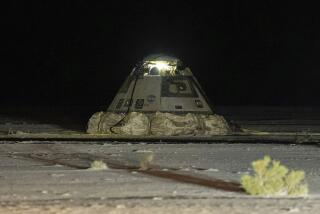NASA Will Retry Shuttle Launch on Independence Day
- Share via
CAPE CANAVERAL, Fla. — The launch of the space shuttle Discovery was scrubbed for the second day in a row Sunday as rain and thunderheads crowded the skies over the launch site in central Florida.
“We’ve concluded we’re not going to have a chance to launch today,” launch director Mike Leinbach told shuttle Cmdr. Steve Lindsey more than two hours before the scheduled launch at 12:26 p.m. PDT.
There was never a good chance of launching throughout the day.
“We went red this morning and stayed red,” said Air Force Lt. Kaleb Nordgren of the 45th Weather Squadron at Cape Canaveral.
Of 10 launch rules, the weather violated at least four, including the presence of lightning, cumulus clouds and high-altitude anvil clouds that could spark lightning as the shuttle ascended.
NASA announced it would “stand down” a day and try to launch at 11:37 a.m. PDT on Tuesday, when the weather is expected to improve.
There are two reasons for taking the day off. The weather today is expected to remain bleak. In addition, the free day will give NASA launchpad workers time to top off the hydrogen and oxygen fuel cells that supply on-board electricity for the shuttle crew during the mission.
To do that, the service gantry must be rolled back out to the shuttle, which is why even small maintenance jobs can take a long time.
This will be the 115th launch of a shuttle and the second since the loss of Columbia in 2003.
NASA managers hope the 12-day mission, which they consider a test flight, will go cleanly so the space agency can resume construction of the half-finished International Space Station.
Last year’s test flight was plagued by troubles, including one -- the loss of a chunk of insulating foam from the fuel tank -- that was similar to the incident that brought down the shuttle Columbia. Unlike with Columbia, the foam chunk did not hit the craft.
Still, the near-miss caused NASA Administrator Michael D. Griffin to ground the fleet, declaring the shuttle would not fly again until the foam issue was solved.
Two weeks ago, Griffin gave the go-ahead for this flight despite concerns by some of his top engineers that the foam problem remained partially unresolved.
NASA removed 30 pounds of foam from the tank that was considered most vulnerable to flaking. But dissenting engineers said that did not go far enough. They worried about probability studies showing that foam could still come off brackets holding the fuel feed lines in place on the external tank.
In an interview Sunday on CNN’s “Late Edition With Wolf Blitzer,” Griffin said he was comfortable with his decision to overrule those experts.
“I judged the odds to be very low that we’re risking a vehicle,” Griffin said.
“I am quite confident that we’ve got a very good chance of flying, and flying safely.”
Griffin has said he based the decision on his analysis of engineering studies that indicated that a series of highly unusual events would have to take place at the same time for serious damage to the shuttle to occur.
More to Read
Sign up for Essential California
The most important California stories and recommendations in your inbox every morning.
You may occasionally receive promotional content from the Los Angeles Times.










